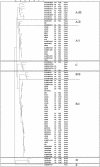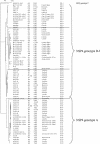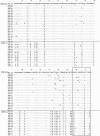Evidence for genetic linkage between the gene segments encoding NSP4 and VP6 proteins in common and reassortant human rotavirus strains
- PMID: 12904356
- PMCID: PMC179808
- DOI: 10.1128/JCM.41.8.3566-3573.2003
Evidence for genetic linkage between the gene segments encoding NSP4 and VP6 proteins in common and reassortant human rotavirus strains
Abstract
NSP4-encoding genes of 78 human rotavirus strains of common or reassortant genotypes were characterized by reverse transcription-PCR followed by sequencing and phylogenetic analysis. It was found that all the human strains characterized clustered into only two of the five known NSP4 genotypes. Linkage between NSP4 genotypes and VP6 subgroups was 100%, NSP4 genotype A being linked to VP6 of subgroup I (SGI) and NSP4 of genotype B being linked to VP6 of SGII. The diversity among the NSP4- and VP6-encoding genes was significantly less than that among the VP7 and VP4 genes in cocirculating human rotavirus strains. Whereas G and P types appear to be shared among different animal species and humans, the NSP4- and VP6-encoding genes appear to segregate according to their host of origin, suggesting that these two proteins may be host restriction determinants. The NSP4-VP6 association may be structurally determined during rotavirus replication (morphogenesis).
Figures




Similar articles
-
Molecular characterization of G11P[25] and G3P[3] human rotavirus strains associated with asymptomatic infection in South India.J Med Virol. 2007 Nov;79(11):1768-74. doi: 10.1002/jmv.20988. J Med Virol. 2007. PMID: 17854037 Free PMC article.
-
Molecular analysis of the NSP4 and VP6 genes of rotavirus strains recovered from hospitalized children in Rio de Janeiro, Brazil.J Med Microbiol. 2007 Jun;56(Pt 6):854-859. doi: 10.1099/jmm.0.46787-0. J Med Microbiol. 2007. PMID: 17510274
-
Genetic variability of VP7, VP4, VP6 and NSP4 genes of common human G1P[8] rotavirus strains circulating in Italy between 2010 and 2014.Virus Res. 2016 Jul 15;220:117-28. doi: 10.1016/j.virusres.2016.04.018. Epub 2016 Apr 26. Virus Res. 2016. PMID: 27130628
-
Sequence and phylogenetic analysis of the VP6 and NSP4 genes of human rotavirus strains: evidence of discordance in their genetic linkage.Infect Genet Evol. 2010 Oct;10(7):940-9. doi: 10.1016/j.meegid.2010.05.017. Epub 2010 Jun 11. Infect Genet Evol. 2010. PMID: 20542145
-
Evidence for independent segregation of the VP6- and NSP4- encoding genes in porcine group A rotavirus G6P[13] strains.Arch Virol. 2007 Feb;152(2):423-9. doi: 10.1007/s00705-006-0848-2. Epub 2006 Sep 28. Arch Virol. 2007. PMID: 17006597
Cited by
-
Approach to molecular characterization of partially and completely untyped samples in an Indian rotavirus surveillance program.Vaccine. 2014 Aug 11;32 Suppl 1(Suppl 1):A84-8. doi: 10.1016/j.vaccine.2014.04.024. Vaccine. 2014. PMID: 25091686 Free PMC article.
-
Molecular characterization of G11P[25] and G3P[3] human rotavirus strains associated with asymptomatic infection in South India.J Med Virol. 2007 Nov;79(11):1768-74. doi: 10.1002/jmv.20988. J Med Virol. 2007. PMID: 17854037 Free PMC article.
-
Genotyping and Molecular Characterization of VP6 and NSP4 Genes of Unusual Rotavirus Group A Isolated from Children with Acute Gastroenteritis.Adv Virol. 2024 Jul 4;2024:3263228. doi: 10.1155/2024/3263228. eCollection 2024. Adv Virol. 2024. PMID: 38993264 Free PMC article.
-
Detection and characterization of waterborne gastroenteritis viruses in urban sewage and sewage-polluted river waters in Caracas, Venezuela.Appl Environ Microbiol. 2009 Jan;75(2):387-94. doi: 10.1128/AEM.02045-08. Epub 2008 Nov 21. Appl Environ Microbiol. 2009. PMID: 19028907 Free PMC article.
-
Distinguishing the genotype 1 genes and proteins of human Wa-like rotaviruses vs. porcine rotaviruses.Infect Genet Evol. 2016 Sep;43:6-14. doi: 10.1016/j.meegid.2016.05.014. Epub 2016 May 12. Infect Genet Evol. 2016. PMID: 27180895 Free PMC article.
References
-
- Au, K. S., N. M. Mattion, and M. K. Estes. 1993. A subviral particle binding domain on the rotavirus nonstructural glycoprotein NS28. Virology 194:665-673. - PubMed
-
- Ball, J. M., P. Tian, C. Q. Zeng, A. P. Morris, and M. K. Estes. 1996. Age-dependent diarrhea induced by a rotaviral nonstructural glycoprotein. Science 272:101-104. - PubMed
Publication types
MeSH terms
Substances
Grants and funding
LinkOut - more resources
Full Text Sources
Medical

